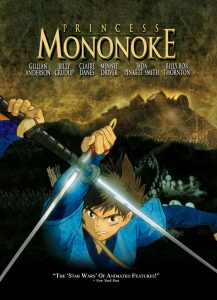Princess Mononoke a Novice Review of Theme
Many themes based on man and their conflict are explored in Miyazaki’s 1997 animated film Princess Mononoke. Of these several themes, three keys recurring ideas proved to be the most potent. First is the age old struggle of Man vs. Nature, next comes the timeless strife of Man vs. Man, and finally, we arrive at the trials and tribulations of Man vs. Self. This dives into the ideas of Implicit and Explicit meanings discussed in the text Looking at Movies by Richard Meran Barsam, Dave Monahan, in addition to one of the cornerstones of cinema theme.
First, we delve into the most obviously present theme of the film Man vs. Nature. The concept of this arguably shapes the films and many actions of the characters along the way, stressing its importance. This is expressed through the fierce battles between man and their beast god counterparts. The idea of man and nature as juxtaposed forces is far from new, however, Miyazaki took an innovative approach to the concept. Nature composes itself as a force to be reckoned, but an aging force; while the human side is beginning to industrialize and is growing into their power. The human half of this is shown through Lady Eboshi, a powerful young leader, and her industry powerhouse of a village “Iron Town” and a young Prince, Ashitaka who was cursed by a demon. In contrast, the prowess and power of the old animal gods can be seen through the Boar God, Okkoto-nushi and the Wolf Goddess, Moro-no-kimi and their weathered yet mighty ways, as well as in a young girl raised by wolves, San. Much to the viewer’s delight, this film is more than just the tireless battle of the old and the new, throughout the film a relationship develops between Ashitaka and the San which comes to fruition and begins to settle the much-disputed war of man and nature.
The next most discernable theme is Man vs. Man. This is a key concept in the film because it both creates a sense of discord and harmony among the human groups; it also adds a new facet to the lens in which we can watch this film through. The most blatant example of this can be seen through the battle scenes in which men are pitted against each other based on the greed of their leaders. Such scenes include the war in “Iron Town” when Jiko-bô’s, a greedy and manipulative monk, army turns on Lady Eboshi’s forces, who were formerly allies, in hopes of seizing leadership to “Iron Town”. This is another classic theme which Miyazaki bends to creative will. Man vs. Man almost always is established as a protagonist vs antagonist; and while yes Princess Mononoke certainly has characters which fall into these roles, the Man vs. Man theme is more exploited through the group’s morals and tactics of achieving their goals. Pitting a man’s morals against another’s makes the theme far more open to interpretation and in turn, this affords each viewer a very personal opinion of the characters and film as a whole.
The Final and most influential theme of this film is Man vs Self, the idea that there are strife and discourse within all people and that those same struggles affect how the individual behaves or interacts with the outside world. This theme is influential in shaping the main characters; Ashitaka faces the possession of a demon which grows with hate and rage, and San battles with the calling of her heart or the calling of her duty as well as her human ties versus her wolf raising. While Miyazaki uses fantastic and seemingly unrelatable circumstances in this animated masterpiece the idea of wrestling with internal struggles is something we all share as humans. The concept is explored further and in greater detail, as the film continues and we as the audience become increasingly intimate with these characters. In the film’s final moments the characters find their own personal resolution which much to the dismay of the viewer ends in an incredibly open-ended and loose new beginning. It creates almost a rift that we as viewers are not accustomed to, yet it is a masterfully utilized tool to call the audience to look inward and find their own conflicts and begin to ponder how we can resolve those issue we face.
Miyazaki expertly tackled three major themes in his 1997 animated film Princess Mononoke; that of Man vs. Nature, Man vs. Man, and Man vs. Self. This exploration of human nature and it’s trials greatly connects to modern society and proves to be incredibly thought provoking. All in all a watch well worth its 134 minute run time.
Sources
Princess Mononoke. Dir. Miyazaki, Hayao. Billy Crudup and Yuriko Ishida. A studio Ghibli Film 1997.
Barsam, Richard M, and Dave Monahan. Looking at Movies: An Introduction to Film. New York: W.W. Norton & Co, 2010.

Leave a Reply